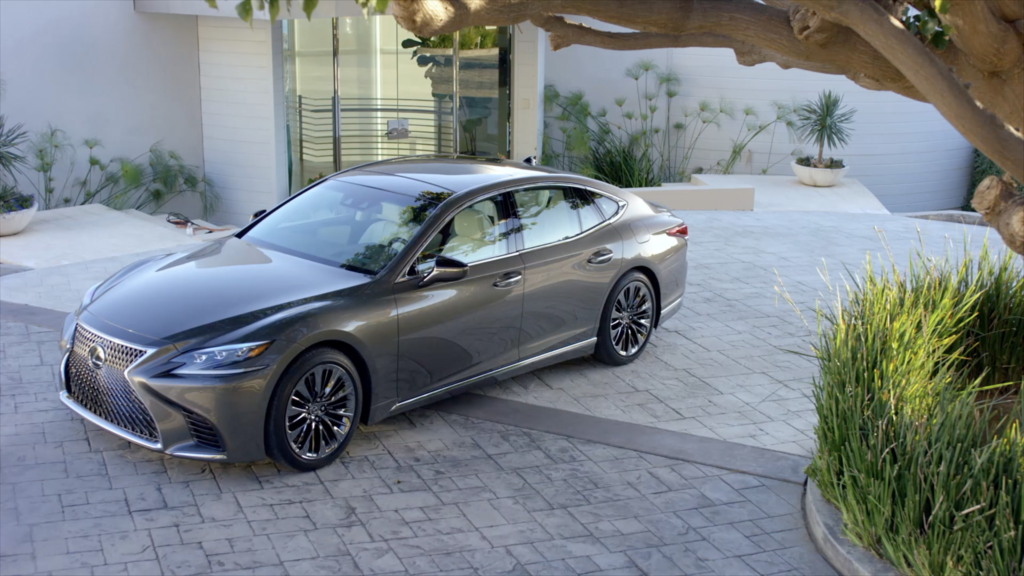This is the 2018 Lexus LS 500 that debuted at this year’s Detroit Autoshow. It’s styling represents a bold yet classic direction for Lexus and is arguably the first design that successfully integrates the brand’s signature spindle grille.
From the front quarter view, the long hood and angular front curves can all be visually traced to the center of the spindle grille. Moving outward the taut lines of the front bumper flow into several dramatic points before blending into the fender and low hood.
The cab-rearward design continues with the base of the A-pillar that is far behind the front axle line and is brought to your attention by a large triangular chrome trim piece. That shape also guides our eyes to the large daylight-opening area. This area is further pronounced by the cut line along the door panel and appears still very large even as it approaches the back of the door edge. This roof height over the rear of the door brings out the shooting brake (think Ferrari FF/ GT4LussoT) look which is becoming a hot design for those who are able to pull it off. Lexus doesn’t make the full commitment but instead manages to successfully blend the shooting brake with the 3-box design of the sedan.
Looking with a more head-on and lower vantage point, the curvature of the front fender is seen highlighted by the bumper to hood line. This necessary gap turned design feature requires an extreme level of tolerance control and consistency in assembly. The cut line along the side blends into the wheel arches creating the appearance of a wide track. The bottom plane of the side of the car is far below the center wheel, contributing to its large stance. The door mirror is pronounced and probably fully optimized for packaging and performance.
Moving around to the rear quarter, the short and narrow trunk lid continues the cab rearward and wide-track theme. The relatively large rear quarter panel, which looks good from the side, is transitioned into a traditionally proportioned rear end. A healthy dose of chrome helps with the visual interest. Overall, the LS’s exterior is a pretty unique shape in a segment that is already full of some of the most forward thinking designs.
The interior continues the theme of a simple curves creating a dramatic effect. A practical minimum amount of buttons is laid out on the IP, which includes the now mandatory, very large in-dash screen. In a unique and sporty touch, Lexus placed two knobs at the top of the sides of the meter cover which control traction control and drive modes. One can find luxurious touches around the cabin such as the door panel which can be considered a piece of art. Carrying the attention to detail theme all the way down to the seats, the position switches are plated and the lower seat trim even has leather stitching. If one has to pick at a fault of this interior, it has to be that this car still uses blanks. Lexus could have purchased another few small dies which wouldn’t be a challenge to engineer. Instead, these plastic trim pieces scream mass production and are a constant reminder that you chose to pay $~85k for this car but somehow justified not wanting those extra features. It’s a mistake and it doesn’t fit with the handcrafted message of the rest of the interior.
control traction control and drive modes. One can find luxurious touches around the cabin such as the door panel which can be considered a piece of art. Carrying the attention to detail theme all the way down to the seats, the position switches are plated and the lower seat trim even has leather stitching. If one has to pick at a fault of this interior, it has to be that this car still uses blanks. Lexus could have purchased another few small dies which wouldn’t be a challenge to engineer. Instead, these plastic trim pieces scream mass production and are a constant reminder that you chose to pay $~85k for this car but somehow justified not wanting those extra features. It’s a mistake and it doesn’t fit with the handcrafted message of the rest of the interior.
Moving the focus to the rear passengers are two outboard seats with leg extensions, controlover the climate, massage, and entertainment via the seatback mounted monitors. It’s becoming clear that the automakers are becoming united in putting up the fight to keep the entertainment within their control which allows more efficient oversight of the applications and functionality.
to the rear passengers are two outboard seats with leg extensions, controlover the climate, massage, and entertainment via the seatback mounted monitors. It’s becoming clear that the automakers are becoming united in putting up the fight to keep the entertainment within their control which allows more efficient oversight of the applications and functionality.
The LS 500 has created a graceful modern take of the traditional luxury sedan style and it’s done so with creative engineering and manufacturing skill. Lexus claims this LS 500 is a new level of flagship luxury in every aspect; Let’s keep an eye out for those mechanical specs and see if we can agree.



